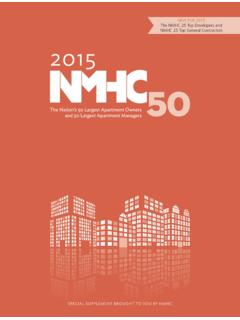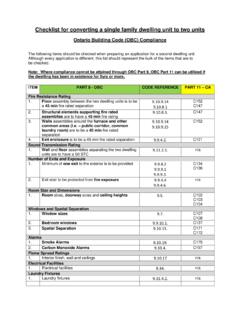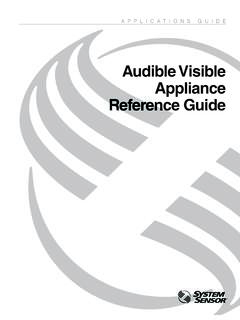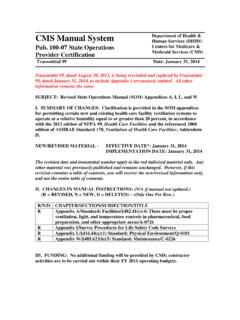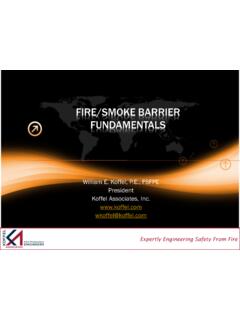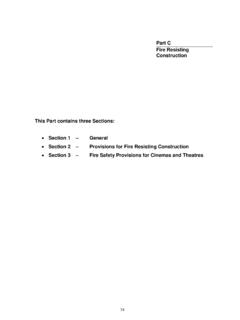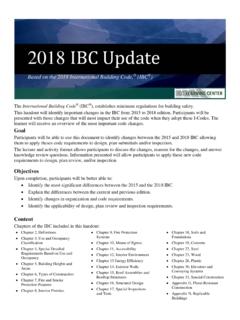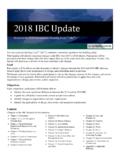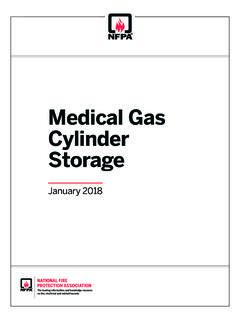Transcription of Important Changes to the 2018 IBC for R-2 (Apartments ...
1 Item #Section(s) & Issue(s)Type of ChangeCost ImplicationComment1E25-15 IBC Egress from stories or occupied roofs. & Egress based on occupant ChangeMeans of Egress from Story or Roof. Clarifies that when determining the means of egress design requirements from a story or occupied roof, each story or roof will be provided with the minimum number of exits for that specific level. The revised language clarifies that an exit access stairway cannot serve as the exits for both floors and ensures that each level is provided with the proper number of Adjacent ChangeDecreaseMeans of Egress Exception. New exceptions have been provided to the provision which only permits the exit path of travel to pass through one adjacent story. These include exit access stairways and ramps in :- Group R-1, R-2 or Congregate residence (R-3) and group R-4 Parking assemblies-Exit components between press boxes, galleries or balconies and the main level of occupancies like auditoriums, sport facilities and places of religious Exit discharge & Illumination level under emergency changeMeans of Egress Lighting.
2 Clarifies that the required illumination within the means of egress illumination shall not be designed such that the failure of an individual lamp in the emergency lighting fixture shall produce less than 1 foot candle level of illumination on the landing. 4E40-15 IBC ExceptionDecreaseReduction in fire Rating. New exception allows for the reduction of the 1 hour fire -resistance rating of the exterior wall assembly between the building and the exterior area of assisted rescue, provided the building is equipped throughout with either a NFPA 13 or 13R automatic sprinkler system. 5E82-15 IBC Stairway ChangeStairway Landing. Clarification regarding the minimum requirement for 48 inches of landing in the direction of travel, when a stairway has a straight run towards the Emergency Escape and Rescue OpeningsNew ExceptionDecreaseException for Means of Egress. Provides new exception for emergency escape and rescue in sprinklered R-2 and R-3 dwelling units.
3 In sprinkler buildings the code will now permit one means of egress and one emergency escape and rescue opening or two means of Column ExceptionDecreaseLight Frame fire Protection. In light frame construction, contractors will no longer have to provide additional protection of the framing members (individual encasement of two or more vertical studs), provided the framing members are enclosed within a fire -resistance rated wall assembly and are located between the top and bottom plates, or tracks. 9FS29-15 IBC Structural StabilityMajor change DecreaseFire Wall Framing. Light frame construction practices have required fire walls to be designed to avoid damage to or structural failure of the fire wall, in the event that the structure on wither side of the fire wall should collapse. fire walls have been required to be anchored to wall framing on either side with break away fasteners and be independent of the structure framing.
4 This new exception allows for double framed firewalls with limited continuous sheathing from one structure to the other, provided the framing complies with NFPA 221 and the sheathing does not exceed 3/4 inch in Sleeping UnitRevised DefinitionDecreaseDefinition of Unit/Sleeping Unit. The significance of the change in defining sleeping unit, is the use of the term unit versus room. In previous editions of the IBC, a sleeping unit was defined by the room in which the occupant had the provisions for living, eating and either sanitation or cooking. By defining the space as a unit, the code will now classify the entire unit where these features are present opening up suites found in dormitories, hotels and assisted living as sleeping Changes to the 2018 IBC for R-2 (Apartments)IBC General IBC-Means of EgressIBC- fire Safety Green - Favorable Action for Multifamily Construction Red - Unfavorable Action for Multifamily Construction Yellow - Item of interest to Multifamily Construction Orange - Fires In Apartments IssueApproved Items Occupied roofsMajor ChangeDecreaseOccupied Roof.
5 This is a major change for defining and classifying the appropriate use of an occupied roofs. These provisions outline the occupant loads, acceptable use groups for occupying roofs or portions thereof, establish the allowable height limitations, provide specific language and guidelines for when the occupied roof qualifies as a story. This change will create a uniform understanding for designers and code officials across the country for occupied roofs and provide the needed guidance for the determining the appropriate level of life safety for allowing the use of the roof as an occupied Private garages and ChangeDecreasePrivate Garage. Previously, the code required a 1,000 square foot limitation on all private garages and for each garage to be separated by 1 hour rated assemblies. Under this new provision, private garages can be built using the same provisions allowed for open parking garages when the garage is used for the private use of a tenant or ChangeGarage Ventilation.
6 Clarification that enclosed parking garages must be provided with a ventilation and exhaust system in accordance with the International Mechanical separation walls in sleeping ExceptionDecreaseDormitory Sleeping Unit. The new exceptions are intended to treat sleeping rooms in dormitories, suites and assisted living spaces as one combined unit. Previously, the code required sleeping rooms to be separated from other components such as bathrooms and living spaces by a fire partition. The exceptions intend to treat these areas similar to that of an apartment and maintain separation from other units and the Dormitory cooking ChangeDecreaseDormitory Cooking. This s a new requirement addressing the use of cooking facilities in dormitives in R-2 occupancies. The specifically limits to the use of domestic appliances and does not allow any cooking appliances in sleeping , fire wall separation of buildingsMajor ChangeDecreaseBuilding separation .
7 Previously, the code required all buildings to be considered independent and separate from other portions of the structure when a fire wall was present. This often required the buildings on either side of the fire wall to be provided with independent means of egress, separate utilities, individual addresses, and self contained life safety systems. This change now clarifies that the fire wall is only provided to ensure that the portions of the building separated by the fire wall is to solely limit the height and area of the building into individual compartments that do not exceed the limitations established by the code. 17G138-15 IBC Mezzanines in residentialRevisionNo ChangeMezzanine Area Increase. The change increases the allowable area for mezzanines from 1/3 to 1/2 of the area of the floor Horizontal building separation OptionNo ChangeVertical Offset in Pedestal Buildings. Change revises the option for pedestal buildings allowing a vertical offsets in pedestal buildings if the fire -resistance rating of the vertical offset is not less than 3 , fire -retardant-treated wood in exterior ChangeFire-Retardant Treat Wood.
8 Previous editions of the building code allowed fire -retardant-treated wood within 2-hour fire -rated exterior walls assemblies, yet was silent on wood sheathing. Language was added to clarify that wood sheathing must also be treated with fire -retardant chemicals in order to be used as part of the 2-hour fire rated Allowable combustible materials for balconies, porches and OptionNo ChangeUse of fire -Retardant Treat Wood. This change adds a new option that allows fire -retardant-treated wood to be used on balconies, porches, decks and exterior stairways that are not used as required exits on buildings three stores or less above grade (New) Emergency communication for the deaf, hard of hearing and speech impairedMajor ChangeIncreaseTwo-way Communications. This significant change in the building code addresses a gap in the emergency two-way communication that is currently provided in elevators for individuals who are deaf, hard of hearing or speech impaired.
9 Under the 2018 IBC, all new elevators will be required to provide emergency communication devices capable of visual and text-based communication and video-based interactive capability to assist those individuals unable to use the current emergency communication systems provided. Based on the limited information provided for the devices in the code and no reference to a performance standards, building owners, designers and elevator provider should first seek the approval by the authority having jurisdiction for any devices or systems prior to installation. 22G201-15 IBC Elevator hoist way opening into Rated corridors ClarificationNo ChangeElevator Lobbies. In previous editions of the code, there was a lack of clarity on whether the elevator hoist way opening was considered protected by the enclosed lobby, when the hoist way opened into a fire resistant rated corridor. The new language clarifies that it is the intent of the code to require opening protection to the hoist way, even when the elevator opens into an enclosed elevator , , , [F] (IFC ), , , , , , , Enclosed elevator ChangeElevator Lobby When Required.
10 This is a multi-sectional clarification throughout the IBC to clarify when an enclosed elevator lobby is fire service access elevatorMajor ChangeDecreaseFire Service Access Elevators. The change consists of two parts, with the first reducing the number of floors served by the fire Service Access Elevators (FSAE) to those floors above and including the lowest level of the building that provides fire department vehicle access. The second part of the change, is elevators that only serve an open or enclosed parking garage with access limited to the building lobby are no longer required to be constructed as a Water protection of hoist wayClarificationNo ChangeWater Protection of Hostway. Clarification that the intent of this section is preventing water from outside the enclosed lobby from entering the elevator hoist , & Occupant evacuation elevatorsMajor ChangeDecreaseOccupant Evacuation Elevators.
